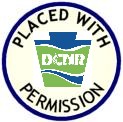This is 1 of 12 EarthCache sights in the SRWT. The first 100 to complete the trail will receive a geocoin commerating the SRWT, 60 of which are trackable. These will be available at the Mercer County Conservation District office Mon.- Fri. from 8 am to 4 pm after April 21st. We are located at 753 Greenville Road, Mercer, PA 16137. To learn more about this geoWatershed Trail, visit us by clicking here.
SHENANGO RIVER HISTORY (Mondok, 1990)
The Shenango River Basin is shared by the state of Ohio and the Commonwealth of Pennsylvania. The river and its tributaries drain 744 square miles of the Pennsylvania counties of Crawford, Lawrence, and Mercer and 285 square miles of the Ohio counties of Ashtabula, Mahoning, and Trumbull. The waters and its tributaries have been used for transportation such as the Erie Extension Canal, watering livestock, and other household uses.
Prior to European settlement, the land area of the Shenango was inhabited by many indian tribes including the Seneca and the Delaware. The word Shenango itself comes from the Iroquoian word Shaningo meaning “beautiful one”.
The 75 mile long river begins in the marshes that are now part of Pymatuning Reservoir near Hartstown in Crawford County and eventually meets the Mahoning River near New Castle in Lawrence County.
ICE AGE INFLUENCES (Mondok, 1990)
The topography and soils in Pennsylvania and Ohio were shaped during the Ice Age that ended about 10, 000 years ago. Prior to this glacial epoch, the Shenango River flowed in a northerly direction to the Atlantic Ocean via the Great Lakes and St. Lawrence River. This dissected plateau was covered by glaciers; some were a mile thick in some places. Boulders, rocks, soil, sand, silt, and clay were carried with the glacial ice and deposited on glacial till, kame terraces, moraines, and eskers when the ice melts as the climate warmed. These deposits were so vast, that their ancient river valleys were filled, causing the flow from the Atlantic Ocean to the Gulf of Mexico.
GEOLOGY OF THE SUGAR RUN AREA (MERCER COUNTY, PA)
The land surface of the majority of Mercer County is a maturely dissected plateau covered almost entirely by glacial deposits of the Kent ice sheet (Wisconsinian stage). These deposits range in thickness from 0 to as much as 400 feet; they are thickest in deep valleys in the bedrock. The bedrock for Mercer County has been greatly studied and has been determined to consist mainly of rocks of Devonian, Mississippian, and Pennsylvanian age. The rocks from the Devonian age are not exposed in Mercer County, but are present beneath the glacial deposits in deep bedrock valleys. The Mississippian rocks are located along valley side and some valley bottoms, while the Pennsylvanian rocks generally underlie the uplands (Schiner and Kimmel, 1976).
Mississippian and Pennsylvanian rocks are mostly composed of alternating units of sandstone and shale. These sandstones tend to frequently intertongue laterally with shales. Note: Pennsylvanian rocks are generally more sandy than the Mississippian rocks (Schiner and Kimmel, 1976).
SUGAR RUN SANDSTONE
As you walk along the banks of Sugar Run, a small tributary that enters into the Shenango River below the Pymatuning Dam, large slabs of rock are seen jutting out along the banks and stream bed. These slabs of rock are sandstone. Awaiting the survey of a geologist, how these rock came to be can be speculated. Maybe they portray the rocks that were carried with the glacial drift some 10,000 year ago; another postulation is that these are the sandstone bedrock from the Mississippian and Pennsylvanian formations that became exposed from the recession of the last glacier in the area. None-the-less, they portray a step back into the glacial periods that forever changed the flow of the Shenango River we know today.
REFERENCES
Mondok, J. (1990). The Shenango River. Shenango Riverscapes, 1-2.
Schiner, G. and G. Kimmel. (1976). Geology and Ground-Water Resources of Northern Mercer County, PA. Water Resource Report, 33, 1-2.
COORDINATES TO PARKING AREA
Park at coordinates: N 41 29.892' W 080 27.508'
(You will know you have parked in the right place if you are below the dam and have to cross a snowmobile bridge to get to the other side of the river.)
TO GET CREDIT FOR THIS CACHE:
Please be sure to send your answers to the following questions to jmccullough@mcc.co.mercer.pa.us in order to receive credit for this cache.
1. Describe the rock formation of the stream. Based on your observations and the reading prior to your visit, postulate what you think these sandstone slabs are- either bedrock or glacier debris. Defend your answer.
2. What is the elevation at this point near the sandstone rocks exposed?
A special thank you to DCNR for permission to place this Earthcache.
